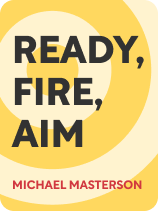

This article is an excerpt from the Shortform book guide to "Ready, Fire, Aim" by Michael Masterson. Shortform has the world's best summaries and analyses of books you should be reading.
Like this article? Sign up for a free trial here.
Would you like to increase your business’s earning potential? Do you feel like you’ve gone as far as you can with the products and services you already have?
It might seem as though you’ve tapped out your customer base and have nothing new to offer. Veteran entrepreneur Michael Masterson shares three ways to build on your success and break through to new territory with new products and new customers.
Keep reading to learn how to expand your business with Masterson’s methods.
How to Expand Your Business
Once you’ve pinned down your marketing strategy, determined which product or service version appeals most to customers, and successfully generated sales for this offer, you’ll be ready to expand your business and your earning potential. Masterson explains how to expand your business by focusing your resources on creating a broader range of offers—targeting your existing market, new markets, or both—and marketing them to both existing and new customers. Masterson explains that this strategy improves your chances of long-term success by:
- Helping you acquire new customers across different markets
- Providing new opportunities for you to profit from your existing customers
- Generating more sales, increasing your profits, and providing a steady stream of income to fund the ongoing growth of your business
(Shortform note: Business experts agree that expanding your product or service line can attract a wider range of consumers and enhance brand awareness, resulting in increased sales and financial stability. However, while this approach sounds good in theory, many companies have failed to successfully create and market new offers, as exemplified by Coca-Cola’s unsuccessful foray into the wine industry in 1977. To avoid similar failures, follow the market research strategies covered in Stage 1 for each new offer you plan to create. This will help you effectively manage the decision-making process for expansion and increase your chances of success.)
In addition to improving upon best-selling products and services in your industry, Masterson suggests three methods to generate ideas for offers that appeal to both existing and new customers:
- Leverage your expertise and resources.
- Take advantage of emerging technologies or market trends.
- Focus on supplementary offerings.
Let’s explore each of these methods in detail.
Method #1: Leverage Your Expertise and Resources
Masterson’s first method for generating ideas for new products or services is to leverage your expertise and resources. This involves drawing upon your existing knowledge, the tools and technologies you have access to, and the networks you’ve established to brainstorm and identify offers that are uniquely tailored to your strengths.
Example: If you researched child development before launching your organic plush toy business, you could use your knowledge to create a line of educational toys that promote critical thinking. Or, you could use the supplies and tools you use to manufacture your plush toys to create a complementary line of matching baby clothing or bedding.
(Shortform note: In addition to drawing upon their existing expertise and resources to create new offers, businesses can also leverage their brand equity. For example, Xiaomi grew to become the world’s leading consumer internet-of-things company by forming alliances with partner firms. Xiaomi offered these partner firms significant value in the form of physical and intellectual resources such as research, development, and manufacturing resources, as well as brand capital—the firms benefited from access to Xiaomi’s millions of existing loyal customers without having to go through the long process of building a customer base and developing trust.)
Method #2: Take Advantage of Emerging Technologies or Market Trends
Masterson’s second method for generating ideas for new products or services is to take advantage of emerging technologies or market trends. This involves actively monitoring the latest developments in your industry and brainstorming innovative ways to capitalize on them.
Example: For your organic plush toy business, you could use virtual reality technology to create a line of augmented reality toys that run on rechargeable batteries. Or, you could capitalize on the growing demand for sustainable products by creating a line of toys made from recycled materials.
| Build Detailed Future Scenarios Osterwalder and Pigneur (Business Model Generation) offer advice for capitalizing on emerging technologies and trends: Create future scenarios that may impact the way you operate. These scenarios will help you prepare adaptation strategies and generate innovative ideas for groundbreaking products and services. To create realistic future scenarios, you need to understand the business environment within which you operate and the various forces that influence it: Market: Which market segments are growing or require attention? Where are customer needs not being met? What issues are driving change? Why are customers switching to competitors? What are customers willing to pay for? Industry: What other companies do you rely on and how do they impact you? Which stakeholders influence how you operate? Who are your competitors and what are their strengths and weaknesses? Who are the new players in the market and what are their strengths and weaknesses? Which products and services could replace yours? Key trends: Which new rules and regulations will affect how you operate? Which technological trends could threaten or enable your business model? Which societal and cultural shifts or trends will influence buyer behavior? What are the demographic trends for your market? Macroeconomic: What overall global market conditions could affect your market? How easy is it to obtain funding? How does the public infrastructure affect your market? What’s the price trend for the resources you need to operate? |
Method #3: Focus on Supplementary Offerings
Masterson’s third method for generating ideas for new products or services is to focus on supplementary offerings. This involves brainstorming add-ons and accessories that provide additional functionality or benefits that enhance the overall value of a core product or service.
Example: Add-ons and accessories that could enhance the value of your organic plush toys include clothing sets to dress them up, furniture sets to create different scenarios, storage solutions to keep them organized, and organic detergents to keep them clean and soft.
(Shortform note: Geoffrey Moore (Crossing the Chasm) provides advice for coming up with supplementary offerings: Provide a whole product for your customers. He explains that core offers typically only provide part of the whole solution that customers need—for instance, when a business sells printers (the core offer) without the peripherals or ink cartridges. To identify your whole product, Moore suggests that you consider everything that your offer depends on or has to interact with in order to solve your target customer’s problem. Then, either provide the whole product yourself or form alliances with other companies that can provide the missing pieces.)
Exercise: Generate Ideas for Products and Services
Masterson suggests that expanding your product or service line boosts your customer base, generates more sales, and funds the ongoing growth of your business. Let’s brainstorm ideas for potential offers.
- Think of a best-selling product or service in your industry and consider ways to improve it—for example, by integrating new features or making it easier to use. Write down at least one idea.
- Consider how you can leverage your existing knowledge, resources, or network to create a new offer. Write down at least one idea.
- Reflect on the trends influencing your industry and consider how you can capitalize on them. Write down at least one idea.
- Choose one of your core products or services and consider what accessories you can offer to enhance its overall value. Write down at least one idea.

———End of Preview———
Like what you just read? Read the rest of the world's best book summary and analysis of Michael Masterson's "Ready, Fire, Aim" at Shortform.
Here's what you'll find in our full Ready, Fire, Aim summary:
- The four stages of development every successful business goes through
- How to structure your management team to handle business operations
- How to effectively market your first product or service





